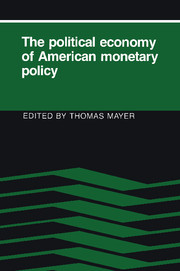Book contents
- Frontmatter
- Contents
- Preface
- List of contributors
- 1 Introduction
- 2 Studying the Fed: toward a broader public-choice perspective
- 3 The Federal Reserve reaction function: a specification search
- 4 Corporate profitability as a determinant of restrictive monetary policy: estimates for the postwar United States
- 5 Federal Reserve behavior since 1980: a financial-market perspective
- 6 The Federal Reserve and its institutional environment: a review
- 7 The political economy of monetary policy
- 8 Political monetary cycles
- 9 Congress and the Fed: why the dog does not bark in the night
- 10 The Federal Reserve as a political power
- 11 Monetary policy and political economy: the Federal Reserve and the Bank of Japan
- 12 A positive analysis of the policy-making process at the Federal Reserve
- 13 A theory of FOMC dissent voting with evidence from the time series
- 14 Explaining FOMC members' votes
- 15 Fed behavior and X-efficiency theory: toward a general framework
- 16 Minimizing regret: cognitive dissonance as an explanation of FOMC behavior
- 17 The discount window
- 18 Leaning against the wind: the behavior of the money stock in recession and recovery, 1953–8
- 19 Bureaucratic self-interest as an obstacle to monetary reform
- Index
9 - Congress and the Fed: why the dog does not bark in the night
Published online by Cambridge University Press: 06 July 2010
- Frontmatter
- Contents
- Preface
- List of contributors
- 1 Introduction
- 2 Studying the Fed: toward a broader public-choice perspective
- 3 The Federal Reserve reaction function: a specification search
- 4 Corporate profitability as a determinant of restrictive monetary policy: estimates for the postwar United States
- 5 Federal Reserve behavior since 1980: a financial-market perspective
- 6 The Federal Reserve and its institutional environment: a review
- 7 The political economy of monetary policy
- 8 Political monetary cycles
- 9 Congress and the Fed: why the dog does not bark in the night
- 10 The Federal Reserve as a political power
- 11 Monetary policy and political economy: the Federal Reserve and the Bank of Japan
- 12 A positive analysis of the policy-making process at the Federal Reserve
- 13 A theory of FOMC dissent voting with evidence from the time series
- 14 Explaining FOMC members' votes
- 15 Fed behavior and X-efficiency theory: toward a general framework
- 16 Minimizing regret: cognitive dissonance as an explanation of FOMC behavior
- 17 The discount window
- 18 Leaning against the wind: the behavior of the money stock in recession and recovery, 1953–8
- 19 Bureaucratic self-interest as an obstacle to monetary reform
- Index
Summary
“The Fed is a creature of Congress.” So Senator Paul Douglas told William McChesney Martin during his confirmation hearings. Senator Douglas went so far as to suggest that Martin paste that slogan on his mirror so that he would see it every morning while shaving. The slogan has some merit. The Federal Reserve was created by a simple act of Congress in 1913. The act has had at least one major set of amendments (during the New Deal), as well as numerous more minor changes. Congress debated, in 1975, the possibility of making major structural changes in Fed-Congress relationships. At any time, by a simple act of Congress, the Fed could be radically changed, or even disbanded. Careful observers (Pierce 1978; Roberts 1978; Weintraub 1978; Woolley 1984) have noted, however, that Congress gives the Fed an unusually free rein.
These observers noted that at least through the 1970s, Congress appeared to play no role in the making of short-run monetary policy. The Fed's legislative mandate appears to be to “make monetary policy in the public interest.” The reforms of 1975 simply mandate that the Fed tell Congress what it did and what it is doing, and why it did not do what it said it would do. Congress gives the Fed a similar free rein in regulating the banking industry. The amendments to the Bank Holding Company Act of 1970 and 1976 give the Fed tremendous latitude to pass on bankholding- company mergers and acquisitions, as well as to determine the legitimate scope of the activities of banks and bank holding companies.
- Type
- Chapter
- Information
- The Political Economy of American Monetary Policy , pp. 129 - 148Publisher: Cambridge University PressPrint publication year: 1990
- 4
- Cited by



